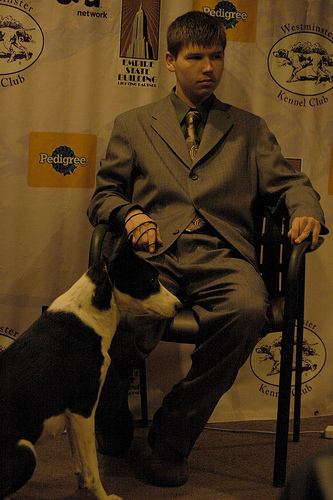Did you ever hear of the dog paddle? Given that there exists a swim stroke named after a dog, some of us assume that all dogs happen to be born understanding the way in which to swim. However this opinion is quite incorrect.
Don't assume every dog instinctively can swim. Quite a few dogs love the water and could simply be trained to swim. These kinds of breeds include water spaniels, Newfoundlands, retrievers, setters, Cocker spaniels, Kerry blue terriers, poodles, Barbets and Hungarian pulis. However, some other dog breeds are only going to learn how to swim with much difficulty or possibly not at all. These dogs include bulldogs, basset hounds, pugs, dachshunds, corgis, greyhounds and Boston and Scottish terriers. If perhaps your dog belongs to the second breed, you could still try to carefully expose them to water by using a flotation apparatus or you might discover they will sink like submarines.
When you expose your dog to the water, remember to use plenty of encouragement. Keep your tone of voice gentle, pleasant and positive. Steer clear of all extreme noises in the spot you're entering. You may find it simplest to check out a dog-friendly body of water where you may slowly and gradually go into the water together with your leashed dog. By walking in to the water with them, you'll improve their confidence within the water. Carry along their favorite toy to use with them in the water. As they gain confidence, you can throw the toy a small distance out and allow them to walk to it. As you go out deeper, they will naturally little by little figure out how to swim rather than walk and you can continue to throw the toy so that they can now swim to retrieve it.
If you are employing a pool to introduce your dog to the water, it might be a little extra effort. A easy way to begin is with a plastic baby pool and then gently persuade your dog to jump in and become wet. You might chuck a favorite toy or treat into your pool for your dog to retrieve. When your dog has become comfortable in the smaller pool, you'll be ready to move on to the larger pool.
Sit at the side of the pool area upon the stairs with your dog laying on your lap. Your dog's two front legs need to be over one of your legs and his two back legs over the other one. For large dogs, spread your legs apart a little bit so that it will be more difficult for them to move. Slowly and gradually work your way in to the pool moving down one step at a time. Permit you dog really feel your stillness while you carefully put a handful of water over her or his back. As you sense your dog resting and his pants become slow and steady, gradually go lower down to the next step. Finally, you will go deep enough in to the water that your dog begins to float up and slowly paddle by himself. Calmly move with your pet, remaining all set to pick them up in case they might panic or become distressed in the water. Toss a treat or a toy to get them to continue to paddle on their own. After a few moments of fun in this initial introduction, gently steer them back towards the steps of the swimming pool so that they can learn how to climb out on their own. By using the leash, you are able to gradually coax them back down the steps so they know how to enter the water by themself. This very first lesson should last roughly 20 minutes. Do not ever force your dog to go swimming if they're not interested.
When you're in an above ground pool with no steps, then just go in the water and pick up your dog from the attached deck. Or maybe you might find that you need somebody to position your pet into your arms while you stand in the water. Proceed as mentioned above, realizing that you will need to raise your dog out of the water once they paddle back to the side of the pool aiming to get out. This might be more labor for you, moving your dog in and out of the pool. But again, all dogs are not the same. Our retriever eventually learned how to leap in to our pool when she wished to go swimming as well as to climb out once she was done.
You may find it useful to introduce your dog to the water while in the presence of one other dog who already can swim. Simply seeing some other dog play in the water could prompt your pet to participate in the good fun. Yet another tip is to always have your dog training bag with you.
Rinse your dog with fresh water soon after swimming. It is especially essential to rinse off swimming pool chemicals, but equally critical in the event your pet was swimming in a lake. Algae and other pathogens found in the water might be ingested by your dog should they choose to lick their fur after being in the water. A good clean rinse can prevent any possible problems. It might also be best if you dry out your pet's ears right after playing in water.
Not every dog will enjoy the water, yet with patience and kindness, most dogs should learn not to fear it. Try to make certain that you're always assisted by your handy bag for dog. Just take your time and be persevering and you may observe that your dog wants to learn how to paddle. After that you may find it difficult to keep your dog out of the water!

 Junior Handler Shows Canaan Dog with Seizure Alert Skill - Westminster 2010
Junior Handler Shows Canaan Dog with Seizure Alert Skill
Junior Handler Shows Canaan Dog with Seizure Alert Skill - Westminster 2010
Junior Handler Shows Canaan Dog with Seizure Alert Skill
 Dog Pregnancy
After a dog gives birth, mos
Dog Pregnancy
After a dog gives birth, mos
 Cane Corso Breeder Interview Breeder Interview: Virginia Dunn Discusses The Great Italian Mastiff
Cane Corso Breeder Interview
The Dog Guide is pleased to p
Cane Corso Breeder Interview Breeder Interview: Virginia Dunn Discusses The Great Italian Mastiff
Cane Corso Breeder Interview
The Dog Guide is pleased to p
 How to Brush Dogs Teeth Without Losing Your Fingers!
After a horrible dental expe
How to Brush Dogs Teeth Without Losing Your Fingers!
After a horrible dental expe
 The Five Laws of Choosing Toys for Blind Dogs
Finding good toys for blind
The Five Laws of Choosing Toys for Blind Dogs
Finding good toys for blind